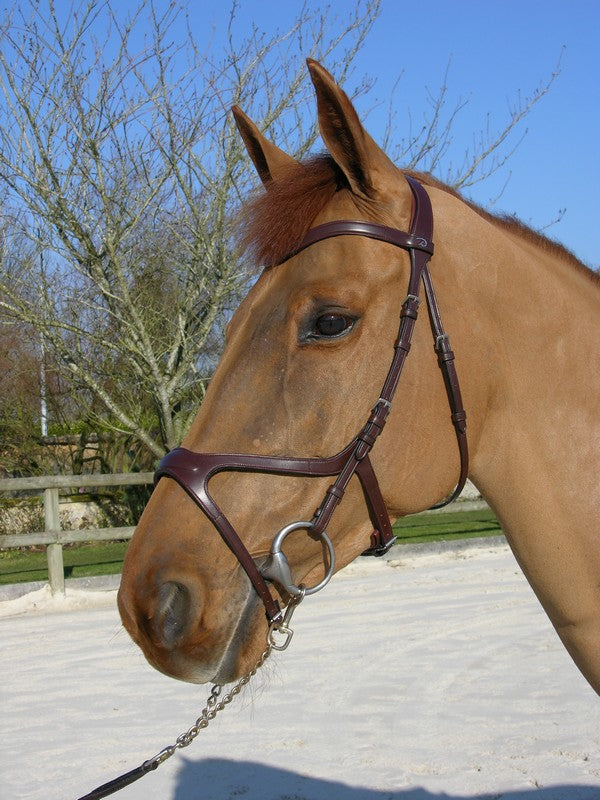Finding the perfect fitting bridle for your horse is essential for your horses comfort and performance, but how do you ensure that a bridle fits properly? With our simple guide you'll be able to check whether the bridle your using fits properly or if you need to find a new one.
Starting with the very basics, bridles generally come in various sizes including Pony, Cob, Full or Oversize. Unfortunately, just like ladies clothing, there are no standard industry sizes for each size so sizing can vary from brand to brand. If you have a question about sizing of a particular bridle brand do not hesitate to get in contact with one of our team.
Generally smaller headed horses, such as thoroughbreds will wear cob size (of course brand dependent), whereas a larger sport horse will need to wear full size or even oversize. A welsh pony will probably need a pony bridle, but a shetland pony will need a shetty sized bridle.
Once you've decided which size bridle you think will be best suited to your horse or pony the best thing to do is try it on. Trying the bridle on firstly without the bit allows you to get a better idea on the fitting without having to quickly adjust bit lengths and cause your horse unnecessary discomfort.
Two of the most important anatomical points of the horses head to pay close attention to when fitting any bridle is the sensitive area around the ears & poll, as well as the cheek bones, or the zygomatic bones. The cheek bones are the part of the horses head that protrude from the face and are a key point of assessment with any bridle fit. As well as these two major points, the bridge of the nose and facial nerves (infra-orbital nerve) are also very important to observe when fitting a bridle. It is crucial to always ensure that the bridle sits on your horses head properly to help prevent unnecessary pressure on these sensitive points which, if not fitted correctly, can cause discomfort and in the long run medical issues for your horse.
Starting from the top of the bridle, check that the crown does not sit to snugly behind the ears. With so many anatomic/ergonomic shaped head pieces now on the market it is relatively easy to now find a bridle which clears the horses ears, allowing freedom of movement and increased comfort. Ideally the headpiece should be softly padded to reduce unnecessary pressure on the poll. If you have a horse that is particularly sensitive in the poll area it may be worth looking at bridles which are cut back away from the poll or leave space in the middle such as the Dy'on Difference Bridle, or the Stübben Freedom Bridle.
Once you've checked how the bridle sits on your horses poll, the next thing to look at is how the browband sits. The browband should sit so that two fingers (stacked) fit comfortably under the front of the browband. A browband that is too big can allow the bridle to slip backwards, whereas one that is too small can pinch the horse and cause the head piece to move forward, putting extreme pressure on the base of the ears.
The throat latch is generally used to help stabilize the bridle, however, now days it is possible that a number of Anatomic Bridles, including the PS of Sweden range, no longer require the throat latch to keep the bridle in place. If you purchase a bridle without a throat latch, it is best to check directly with your Federation if it is competition legal. If your bridle has a throat latch you should be able to fit four fingers (stacked) between the horses throat and the throat latch. This ensures there is enough room for the horse to move comfortably, but that the bridle is not too loose.
In general, the cheek pieces attach from the head piece as a separate piece, however, there are a number of bridles, including the Dy'on X-Fit Bridle which combine the noseband and the cheek piece into one piece. This design creates a unique cut to free the temporal and zygomatic bones (cheek pieces). Whether your bridle has a noseband/cheek piece single strap or a traditional separate cheek piece strap, it is important to ensure that the cheek straps are the correct length for your horses head as the bit needs to be able to sit correctly in your horses mouth.
If your bridle has a noseband, it should fit approximately two finger widths under the Zgomatic Ridge (the boney part on the front of the horses face). This ensures that the noseband will not press on the sensitive nerve bundles which could cause discomfort when being ridder. When doing up the noseband, this same two finger rule applies to ensure that the noseband is not done up too tight. It should be secure but not too tight, this is also the case with the flash strap (if your bridle has one).
Once you have checked off all these steps you should have a well fitting bridle that will keep your horse comfortable and allow them to perform at their best.
Should you require any assistance with fitting a bridle to your horse, please reach out to one of our team at any time. We can arrange a video call or you can send through pictures of the bridle on your horse for further advise.




